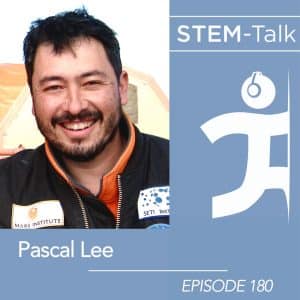STEM-Talk: Pascal Lee on returning to the Moon — and heading to Mars
Published 4.9.25
Dr. Pascal Lee had led more than 30 expeditions to the Arctic and Antarctic to gain knowledge for a greater adventure — Mars.
Lee, a planetary scientist with the SETI Institute, the Mars I nstitute, and NASA Ames Research Center, brings his vision for reaching this next, lofty goal to his third appearance on STEM-Talk, available now wherever you listen to podcasts.
nstitute, and NASA Ames Research Center, brings his vision for reaching this next, lofty goal to his third appearance on STEM-Talk, available now wherever you listen to podcasts.
“The return to the moon is one of those things we would have expected to happen much sooner. And even the journey to Mars, I had always hoped that we’d be much farther along by now,” Lee says. “But this is feeling like it’s going to happen soon.”
Lee’s past appearances were Episode 121 in 2021 and Episode 17 in 2016. He also gave an Evening Lecture on our Pensacola campus in January 2025.
His research focuses on the history of ice and water on the Moon and Mars and the possibilities of exploring both of these worlds. Earlier this year, he and his student, Sourabh Shubham, announced the discovery of a previously unrecognized giant volcano on Mars, the Noctis Volcano.
“It’s not the largest volcano on Mars, it’s not the tallest volcano on Mars, but in contrast to all other volcanos that we know of, which are relatively well preserved, this one is so deeply eroded that not only do you see the outer lava layers and eruption layers, you also see the ancient ones that would have been buried inside the volcano,” Lee says.
While Mars exploration is more prevalent in recent popular imagination, Lee maintains that returning to the Moon and establishing a permanent base there is critical to the future of human space exploration.
“I see the moon as a scientific jewel,” he says. “There are so many things we can explore,” including caves on both the Moon and Mars, which could act as possible refuges for humans there. “You are protected from the ionizing radiation of space, you are subject to dampened temperature variations, protected from micrometeorites … Caves are the difference in something that is much more survivable for life from Earth versus the surface,” Lee says.
Lee has suggested setting up a lunar base at the floor of the Clavius crater. Clavius is where the moon base in the movie “2001: A Space Odyssey” was located, as well, Lee notes. “The fact that we could establish a base at Clavius and be on our way to fulfill the vision of ‘2001’ would be something very attractive to the public.” Beyond the cinematic and poetic importance, Lee says “Clavius has become the place to beat” as a lunar base homeport site.
The conversation also covers:
- What is appealing about exploring the Rutherford Crater caves near the Clavius crater. The caves “hold the promise of being cold enough to possibly have water-ice trapped in them. Being at Clavius gives us a nice opportunity without having to drive too far to explore a large number of caves on the moon which will pave the way for doing the same on Mars.”
- How contemporary interest in human space exploration appears tied to current geopolitical issues between the U.S. and China, much like the first space race between the US and USSR.
- The role nuclear power will play in the future of a lunar base.
- The prospects of colonizing Mars. “The life support system that a crew needs is essentially an intensive care unit. Why would you want to raise kids on Mars in an intensive care unit, in a place where they will never have a breath of fresh air, where they will not know the outdoors as we know the outdoors. I think some people who see Mars as this promised land are for some of them trying to escape the reality of the Earth, and that is not a good reason to go to Mars.”
- What makes the Martian moons Phobos and Demos so intriguing.
IHMC is a not-for-profit research institute of the Florida University System where researchers pioneer science and technology aimed at leveraging and extending human capabilities. IHMC researchers and staff collaborate extensively with the government, industry and academia to help develop breakthrough technologies. IHMC research partners have included: DARPA, the National Science Foundation, NASA, Army, Navy, Air Force, National Institutes of Health, IBM, Microsoft, Honda, Boeing, Lockheed, and many others.
Latest News
- STEM-Talk: Pascal Lee on returning to the Moon — and heading to Mars
- Aging Symposium draws experts to IHMC
- IHMC hosts Fredric G. Levin Lung Care Symposium March 27-28 in Pensacola
- Humanoid robotics and exoskeletons lead latest IHMC newsletter
- Celebrate Robotics Week at IHMC Open House on April 11, 2025
- Registration open for 2025 Summer Robotics Camp
- STEM-Talk: JP Errico on vagus-nerve stimulation, inflammation and chronic disease management
- STEM-Talk: Karl Herrup on shortcomings of Alzheimer’s research
- Pensacola attorney joins IHMC Board of Directors

